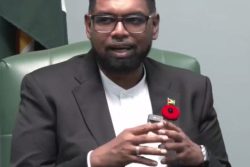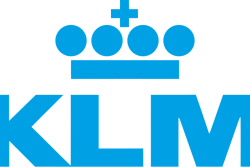Unless government comes up with a “proper plan” for renewable energy, US$80 million earmarked for the Amaila Falls Hydropower Project (AFHP) will return to Norway, Director of Norway’s International Climate and Forest Initiative Per Fedrik Pharo has told members of civil society.
Pharo and coordinator for the Guyana-Norway forest protection partnership Marianne Johansen visited Guyana on Monday to discuss the future of the partnership. They met with President David Granger and some members of his cabinet. Subsequently, the team met with members of civil society. High on the agenda was the future of the partnership and its flagship project, the AFHP.
Minister of Finance Winston Jordan, while presenting the 2015 National Budget to the National Assembly on August 10th, said currently the cost of financing the AFHP is too high and the Inter-American Development Bank (IDB) considered the project too risky to attract the bank’s financing. Guyana was seeking partial financing from the IDB. Jordan said that as currently configured, “it would not only be irresponsible, but a downright criminal act of deception,” if government proceeded with Amaila.
“We know now, that as configured currently, the cost of financing is too high, and that unless the price tag can be substantially lowered, we cannot proceed. In this opinion, we are strongly supported by the experts at the Inter-American Development Bank, who had considered the project to be too risky to attract the Bank’s financing,” he had said.
The declaration would seem to be the end to what was the former PPP/C government’s most ambitious project to diversify energy sources and what would have been the most expensive in the country’s history.
In 2009, Guyana and Norway inked a five-year pact under which Oslo would pay up to US$250 million up to this year based on Guyana’s efforts in protecting its forest and meeting enabling indicators. Guyana has so far earned US$190 million, with US$69.8 million transferred to the World Bank administered Guyana REDD+ Investment Fund (GRIF) and US$80 million to the IDB for Amaila. US$40 million remains in Norway with the final year of the partnership -2014- still being assessed. Both Oslo and Georgetown had previously indicated a desire to continue the partnership.
Minister of Indigenous’ Peoples Affairs Sydney Allicock, who was part of the government team that met the Norwegians on Monday, told Stabroek News that the Norwegian team indicated their interest in government’s plans for the partnership and discussions have started and “it is going to continue because we have some issues that we’d like to be able to discuss further.”
He said this includes the AFHP. The minister said Amaila was high on the agenda at the meeting. “Yes, they were actually saying… that was the flagship” project of the Low Carbon Development Strategy (LCDS), he said, while adding that the David Granger administration has a lot of areas that needs to be clarified and discussions are in progress and there is a team continuing the discussion and the planning. He said the government will also examine other reports. “I believe that we need more time to have it discussed properly, we need to consult a little more,” he said, while also adding that the Minister of Finance is on the ball and is going to engage others very soon.
After the meeting with the government team, the Norwegian team met with members of civil society. One attendee, who spoke on the condition of anonymity, told Stabroek News that they were told by Pharo that Oslo is open to a new agreement but are not sure of the new government’s views on it, hence the visit.
The source said that Pharo indicated that Norway wanted to hear from government and civil society about the partnership and how it proceeded and what they want to see. The source said that they were told that in relation to the US$80 million transferred to the IDB for Amaila, the money would go back to Norway unless the new administration comes up with a different plan for renewable energy which has to be agreed to by both governments. The current agreement will also have to be re-negotiated. The source said that Pharo referred to press reports on the AFHP that the IDB will not support the project.
In the letter agreement pertaining to the US$80 million transfer from the Norwegian Agency for Development Cooperation (NORAD) to the IDB in December last year, it was stated that the IDB Board is also expected to consider in connection with the AFHP, a loan from the Bank to provide financing for the project. If the IDB has not approved the loan and the grant on or before 18 months from the date of the transfer, and unless the Bank and NORAD agree to extend the time, the IDB will have to return the contribution and if applicable, any investment income to NORAD.
The agreement also states that Norway reserves the right to review the use of the contribution. Norway and the Bank shall discuss, in good faith, the nature, scope and conduct of such review or evaluation, and the Bank shall provide to Norway such information as Norway shall reasonably request within the limits of its confidentiality agreements, policies and procedures, the agreement states.
Before US-based Sithe Global pulled out here in August 2013 as the developer of the US$858.2 million, 165 megawatt hydro venture, the AFHP was shrouded in controversy as costs escalated.
Since the project was first announced, costs of the project have escalated from the original US$450 million to US$858.2 million up to 2013. It was also revealed that the costs for the access road had ballooned from US$15 million, when the contract was signed in 2010, to US$41 million last year.
Sithe Global pulled out of the AFHP in August, 2013, citing a lack of political consensus. The company had issued explicit statements that unless all three parties in Parliament backed two measures for the controversial US$858 million project it would pull out. The measures were not fully supported and the company walked away.
The IDB had been expected to partially fund the AFHP and at the time of Sithe Global’s pullout, the Bank was conducting due diligence but that was halted before it was completed due to the pullout. The due diligence was being done to determine whether the IDB would participate in the financing of the project.





